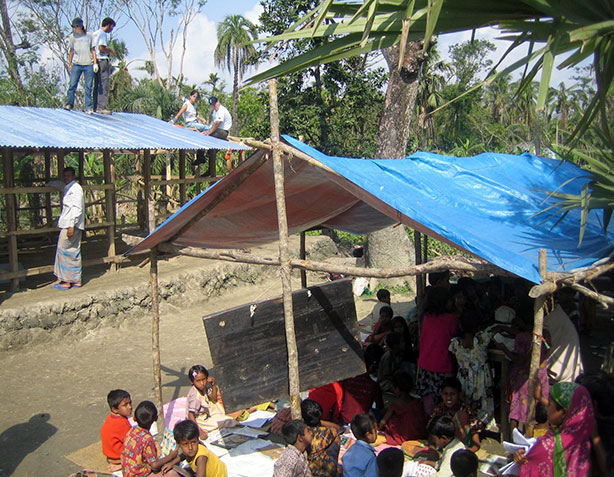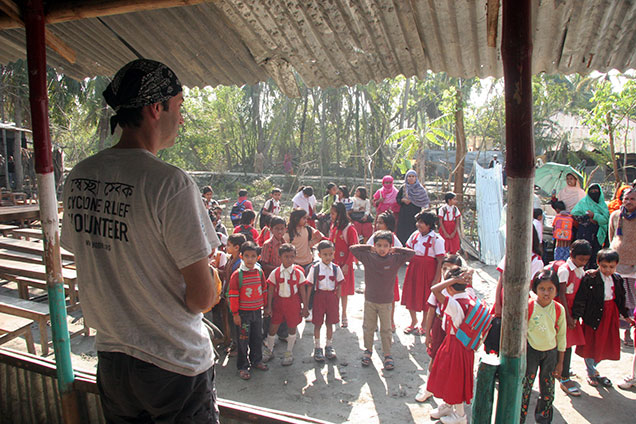
With 25 volunteers in the house, we continue to grow and expand the projects we’re working on! Here’s a look at our second month in Bangladesh:
Kodamtola Informal School
Building on our partnership with IAT-West (Interagency Assessment Team, comprised of the U.S. State Department, Department of Defense (DOD), USAID, and various branches of the armed forces), we’ve rebuilt a rural primary school in the neighboring village of Kodamtola.
Work started with demolition, ground raising, and erecting a temporary structure for the students. As the kids looked on from under their bright blue tarp (ok, they actually spilled onto the build site pretty much all the time), we framed a new 30′ x 12′ multi-room structure for the school. We completed the roof with tin, and the school will finish off the walls with chas, a local, natural woven material.
Jump, Swing, Slide
Our playground-building partnership with Save the Children is off to a strong start! After pre-fabricating all of our playground pieces at our base in Rayenda, we loaded up two fishing trawlers and cruised down to Tafalbari, site of Playground #1. Unloading finished in record time, thanks to our fire-chain of nimble-footed children! Alongside the community, we dug holes, assembled the equipment, poured cement, and finished it off with two coats of bright, primary-colored paint. Today, we’ll invite the children to join us in finishing off the playground with a fresh set of pint-sized handprints!
There are four playgrounds left, and we’re in the process of pre-fabricating the lumber, pipes, rope, and hardware for each remaining set. This week, we’ll load up another couple of trawlers and head to the Ali Khan School, founded by a freedom fighter in the Bangladeshi Liberation War.
Amragacchia English Medium School
During the assessment phase, we passed by this school numerous times. Near the collapsed building, amidst downed trees and a thrashed schoolyard, children still sat at their desks in straight rows with bright blue uniforms freshly pressed. This image of perseverance stuck with us, and thanks to a generous donation from one of our first volunteers, we were able to return this month and rebuild, from the ground up.
First we constructed the framework for a new 42′ by 13.5′ building and used trusses to form a hip roof. We’re cladding the roof and 3 walls in tin, and the front will be a combination of tin and carved wood (in the local style). The interior walls, to separate rooms for different class levels, are of local material called bera. All the while, the students have been attending classes in temporary thatch structures adjacent to our build site. How’s that for studying hard?
Morrelganj Hindu Temple
Although Bangladesh is a Muslim country, there’s a strong Hindu population in the area. IAT-West identified a 100 year old Hindu temple which lost its roof in Cyclone Sidr, and HODR collaborated on the repairs.
After winding through some market streets, cutting through a dry goods shop, and then passing through a family’s personal residence, you emerge upon the small temple. Despite the challenges of working on an old structure, we framed, shimmed, and straightened a shiny new roof for the temple. It was a unique opportunity to work at an active place of worship, while the community passed to worship beneath us!
2 Halves = 1 Whole
In the past month, we’ve built 5 more HODR Halves! Our teams of volunteers continue to refine and improve each step of the process, from the design, framing, and materials, to the finishing touches of doors and windows. Each recipient family faces a unique set of challenges in their Sidr recovery, but they’ve all been equally grateful for their new homes.
Previous HODR Half recipients have also been seen building their own additions onto the framework we left them, effectively creating “HODR Wholes”!
Smile!
The village photo project continues! In addition to the village shots from around our house and our work sites, we’ve also set up “school picture” projects at each of our school build sites. Each student will receive a personal headshot and a class photo – likely the only images they’ll have of themselves at this age. So far we have printed almost 1000 photos for our friends and neighbors in Sharonkhola.
Un Poquito Mas, Bangladesh style
The community has started to express their appreciation for our work and our volunteer effort with invitations for lunch, dinner, dancing – in once case, even a serenade by a one-man harmonium band! Our hosts take immense pleasure in treating us to elaborate 7 course meals; if we politely decline a serving of extra rice, as soon as we turn our head they’ve scooped it on to our plates and are laughing at our surprise. What can you do? It’s Bangladeshi shopota, or culture/hospitality.
We’re almost ready to form a hospitality team to manage our social calendar while still making sure we have time to get work done! It is awe inspiring and humbling to be in the shelter of a landless person, who wants nothing more than to demonstrate their appreciation by sharing food with us.
You still have about 45 days to join us in Bangladesh. Come see what all the fun, hard work, and shopota are about!

Marc Young
Operations Director
Hands On Disaster Response
 HODR’s 2008 Project Rayenda, Bangladesh was featured in the February 2009 edition of Project Management Institute’s magazine, PM Network.
HODR’s 2008 Project Rayenda, Bangladesh was featured in the February 2009 edition of Project Management Institute’s magazine, PM Network. 




